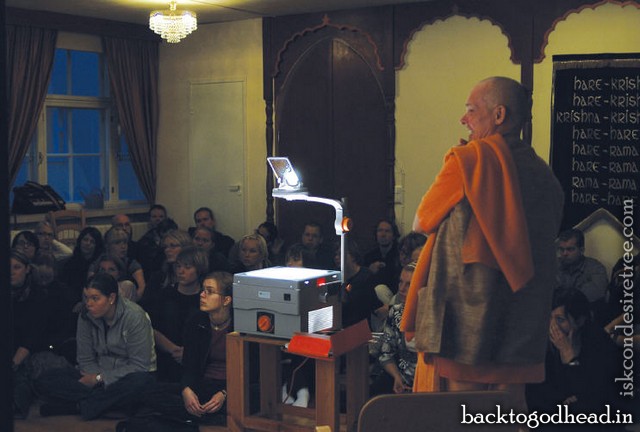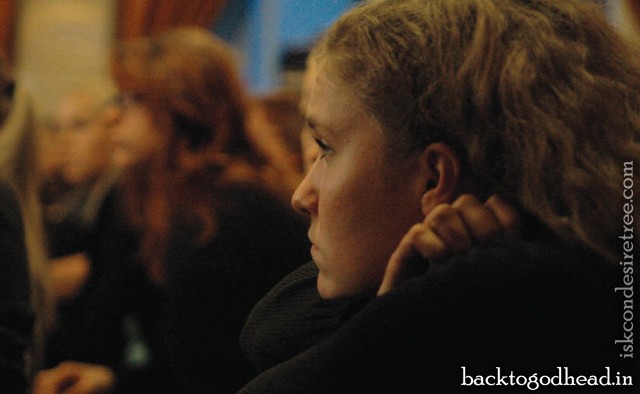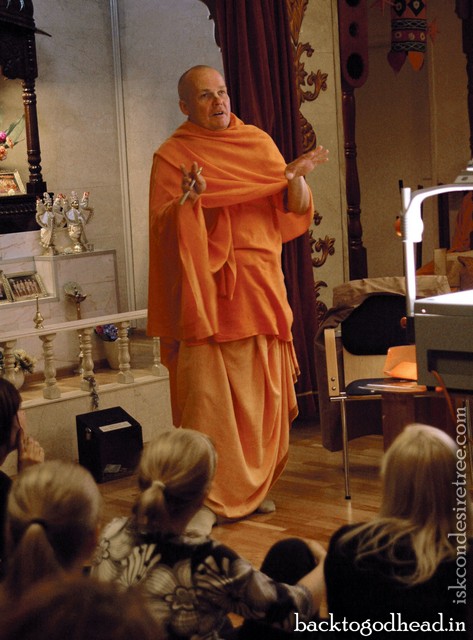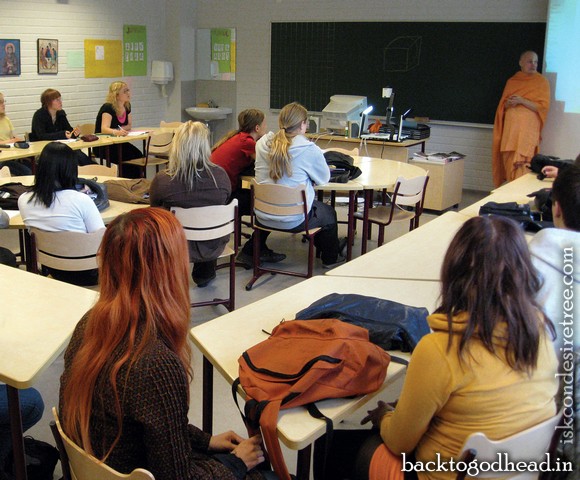The materialists have knowledge, but it is disconnected from sabda, the Vedic source, Tattvavada continues. Real knowledge means seeing how every aspect of the human existence connects to the Supreme. The word university comes originally from the verb “to unify” and means to see unifying connections. Also, in the Vedic conception, mere knowledge is not enough; one has to act according to that knowledge to realize it.
Tattvavada then speaks about the physical and the metaphysical, drawing on the Vedic terms sanatana-dharma (concerned with the metaphysical) and varnasrama dharma (concerned with the physical). He uses Powerpoint presentations, transparencies, and pictures to make his points. At the end, students ask questions, especially on ethical issues.
My Trip to Finland
I was glad to finally see Tattvavada in action. He is ISKCON’s regional secretary for Finland and the Helsinki temple president. I met him one winter while I was visiting the holy birthplace of Sri Caitanya Mahaprabhu in Mayapur, West Bengal. When he told me he was sharing knowledge of Krishna with Finland’s academic community, I wanted to see his work firsthand.

My opportunity came the first week of September 2008, when the school year started. Tattvavada invited me to stay through Radhastami, September 7, and be his temple’s guest speaker.
The Finnish devotees are dedicated to giving lectures in high schools and colleges, conducting programs for temple visitors, and distributing prasadam and books of Vedic wisdom. They lecture in Hare Krishna attire and develop friendships with teachers. For most of the students, the ideas discussed in the lectures are new but plant a seed of interest in Vedic knowledge, specifically Krishna consciousness. Avadhutacandra Dasa, leader of the Hare Krishna book distribution party in Finland, told me he had just met a well-dressed professional who had heard a devotee speak to his high school class some years ago. The man was eager to talk with Avadhutacandra and bought a copy of Prabhupada’s Science of Self-Realization. Avadhutacandra has met many people while on book distribution who have developed interest in Vedic wisdom because of the school presentations.
Lectures in classes on religion, philosophy, and psychology are just one venue for sharing Vedic knowledge in Finland. Another is entire courses on Krishna consciousness. In 2002, Tattvavada Dasa, originally a captain in the military, was invited to help the Finnish parliament decide on new religious laws. United Nations Article 27 states that every child has the right to be taught the teachings of his own religion. In most countries this is not enforced, but in Finland, after some debate, the parliament ruled that if there are at least three children of any religion in a city, the parents can request their local school to teach that religion. As a result, all the officially registered religions, including the Krishna religion, got the right to teach their own children in the schools.
“That’s a great beginning,” Tattvavada told me, “but my hope is that in the future the rule will be that students can choose to attend whatever religion courses are available, not just the course for the religion they are members of.”
In light of the parliament ruling, Tapo Divyam teaches the Krishna religion, based on Srila Prabhupada’s teachings, to seven classes a week in greater Helsinki.
“To my knowledge,” says Tapo Divyam,” our opportunity to teach Krishna consciousness as an official religion class in the schools is unique in the world.”
He then reminds me of something Srila Prabhupada said: So in the present material world they are interested in understanding atma the body. The medical science, physiology, biology, they are studying the science of the body. And some of them are studying the science of mind, psychology thinking, feeling, and willing. But nobody is studying the deepest meaning of atma: soul. There is no university, school, college throughout the whole world to understand the soul.
“Now for the pleasure of Srila Prabhupada and the disciplic succession,” Tapo Divyam says, “and by their mercy, we can teach the science of the soul even in regular schools.”
Students from Nepal
I visited a class attended by six Nepali boys. As it was the week after Srila Prabhupada’s Vyasa Puja (birth anniversary), Tapo Divyam handed out a fact sheet about Srila Prabhupada’s contributions, read from Srila Prabhupada-lilamrta, displayed copies of Srila Prabhupada’s books and talked about them, and showed the students several pictures from the new Prabhupada photo book.

The students’ interest increased as the class progressed, and its end came all too soon. The boys already knew some things about their Vedic heritage. One proud son of a brahmana even showed off his brahmana’s thread. It’s easy to understand that the Vedic worldview, culminating in devotion to Krishna, as described in the Bhagavad-gita (e.g., 15.15, 18.64– 18.66), should be discussed in school as well as at home. That could prevent the boys from losing touch with their spiritual culture, the most important part of life. Tapo Divyam has another class with all Indians, and one with four students from India, Bangladesh, Sri Lanka, and Nepal. Two of the classes are in English, and the other five in Finnish.
Muniraja Dasa also teaches courses on Krishna consciousness in the public schools. “Our academic outreach is very nice,” he told me, “but it is the result of a lot of work, and it takes thoughtfulness to maintain the situation and go further. I always meditate on the instructions of Suhotra Swami: ‘We cannot be in a mood of conversion when dealing with materially learned persons; rather they should be attracted to the devotees’ knowledge and qualities.’”
During my visit, I noticed that Tattvavada spends easily as much time after classes talking with the teachers as he does talking to the students. The teachers often ask questions about how to present the Krishna religion to their classes accurately.
After the lecture I attended, the younger of the two teachers conducting the class told Tattvavada, “I came to your temple four years ago with the university group. I still remember the exact words and the tune you were singing.”
Tattvavada also spoke with a teacher in the next room who was writing textbooks for all Finnish schools. She wanted to invite him to give suggestions for the next textbook. When he gave her prasadam, she had one of her students distribute some to the entire class.
“Our friendships with the teachers have been developing for a long time,” Tattvavada says.
Tattvavada has also been training teachers at the University of Helsinki. This will be one of the functions of the imminent college branch described below.
“I’m careful to never break the trust I’ve established with the teachers,” Tattvavada says. “I don’t encourage people to leave their studies and join the Hare Krishna movement on the spot. I just give people information about Krishna consciousness, so both teachers and students are aware of the truth about it.
“Scientists offer some philosophy but no religion, and other religionists offer some devotional sentiments but are weak in philosophy. The Krishna teachings, however, integrate philosophy and religion and can satisfy both the emotional and the intellectual needs of the living being.”
Tattvavada’s friends in academia have often helped ISKCON Finland. Ten years ago, when the European Union was beginning, the atheistic French government sent representatives to different countries to convince them that the Hare Krishnas were an evil sect that should be stopped. On hearing from a French delegation, one of Tattvavada’s Ph.D. friends was upset to hear all their erroneous negative propaganda and strongly defended the Krishna religion.
One Ph.D. who trains religion teachers has been inviting Tattvavada to lecture for the past ten years. Now he yearly brings his entire class to the Helsinki temple. Last year the professor brought twenty-five undergraduate Christian priests and their teachers to Vrindavan, India, the center of devotion to Krishna. Tattvavada took them on the pilgrimages to Govardhana and the town of Vrindavan. A class of nurses comes to the Helsinki temple every year as a part of a multicultural course, since the nurses need to learn how to deal with patients with various religious views.
Recently, a highly respected professor of comparative religion at the University of Helsinki asked Tattvavada and Tapo Divyam to prepare a curriculum for a Krishna studies minor for Finland.
Bhaktivedanta College
Tattvavada’s next step is to start an institute of high education. It will be a branch of Bhaktivedanta College Budapest (BHAKTI), the only devotee-run university that is accredited and can award graduate and post-graduate degrees. Founded ten years ago, BHAKTI has 350 students. Bhaktivedanta College in Finland will start offering courses in the autumn semester this year. Once the Finnish devotees join with BHAKTI, religious educators and students in Finland will be able to get academic degrees by studying the Krishna religion under qualified devotee teachers. Helping to make the Finnish branch a reality are Sivarama Swami; Devamrta Swami; Gaura Krishna Dasa, the BHAKTI headmaster; and Radhanatha Dasa, a key expert behind BHAKTI who has good connections in the academic community.
The Finnish devotees are also working with Bhakti Vidya Purna Swami and the Bhaktivedanta Academy in Mayapur, India. Teachers have come from there to teach the Finnish devotees, with classes on Vedic education, literature, yajñas, and other arts.
Laksmi Mani Dasi, who has been involved in education in the Hare Krishna movement for over thirty years, came to Finland to help train teachers.
“The devotees in Finland have a unique opportunity,” she says, “in that Finland is offering them a rare chance to share the knowledge we have been given. The devotees in my teachers’ training class were outstanding in their desire to learn how to get their point across. They are enthusiastic and kind; some are exceptional teachers.”
The complete focus on spreading knowledge of Krishna to others was more and more evident to me during my stay in Finland. The successful academic program shows what honest and sincere devotees can do by taking the time to cultivate relationships with people in the academic community.
The History of Hare Krishna Educational Programs in Finland
Trained by Suhotra Swami, Tattvavada Dasa began to lecture in colleges and universities in 1993. Two years later, Suhotra Swami began to meet scholars in Finland, with scheduling help from Nimi Devi Dasi. Starting in 1997, Tattvavada organized visits by Suhotra Swami to universities all around Finland. Suhotra Swami’s books and philosophical presentations earned respect in the academic community, for both himself and the Hare Krishna movement. A few universities still use his books as textbooks.

A weekly religion class is compulsory for Finnish students with a religious background. For fifteen years, Tattvavada has been lecturing on world religions, religions in Finland, the Krishna religion, ethics, philosophy, and psychology. At present, Tapo Divyam Dasa, Avadhutacandra Dasa, Muniraja Dasa, and Tivra Bhakti Devi Dasi assist him. They lecture at six of Finland’s ten universities and in one hundred colleges and high schools, reaching somewhere between seven thousand and eight thousand students a year.
“When we started lecturing in colleges,” Tattvavada says, “we thought it would be too difficult to get into most of them. But now, after seventeen years, our biggest challenge is having enough time for all the colleges and universities that want us.”
Besides schools, colleges, and universities, Tattvavada has lectured at well-respected academic clubs, including a literature club for academics, a quantum physics club, and a club for Mensa members. He also takes part in many interfaith discussions. His motto, taken from a letter Prabhupada wrote to Hridayananda Dasa Goswami, is “Every center should be a college.”
Each week, at least two or three school groups visit the Hare Krishna temple in Helsinki adding another three to four thousand students a year to the number of those hearing from devotees in their classrooms.
Other Programs of ISKCON Finland
While Tattvavad a is giving classes and talking to teachers, in the same city his traveling group of about eight devotees distributes spiritual literature and prasadam labeled bags of dried fruit or cookies. Tattvavada distributes books during breaks in his class schedule.
Besides the academic programs and book distribution, in at least fifteen locations yearly throughout the country the devotees put on a festival called “India Experience,” with bhajanas, dances, dramas, lectures, films, and prasadam. In July in northern Finland, Finnish and Indian devotees conduct their own festivals or take part in those of others. At World Village, a festival in Helsinki, the Hare Krishna food is the most popular. At one “ethnomusic” festival, the devotees sold over a thousand plates of kitri, pakoras, and halava.
A couple of years ago the Finnish devotees began to put on a Rathayatra festival in Helsinki. This year they plan to follow the example of the temples in the other Scandinvanian countries and invite Parasurama Dasa to come with the London Rathayatra chariot for festivals in Helsinki, Tampere, and Turku, Finland’s largest cities.
The Helsinki temple has fifteen unmarried devotees, male and female, and ten married couples regularly involved with temple activities. Life members and active supporters number around a hundred. There are Hare Krishna congregations in sixteen cities.
The Helsinki temple gets regular visits from senior devotees, who often conduct seminars for the congregation. A source of income for the temple is the monthly cooking classes that have been going on for years. The devotees also have a small vegetarian club at the temple, serving lunch (on Thursdays and Saturdays) and catering samosas to local businesses during the week.
Krishna-krpa Dasa, a devotee for twenty-five years, travels to promote the public congregational chanting of Hare Krishna, teaches classes on Krishna consciousness, is a Krishna.com LiveHelp volunteer, and proofreads BTG and other publications. You can write him at kk@ krishna.com.

